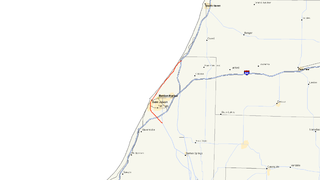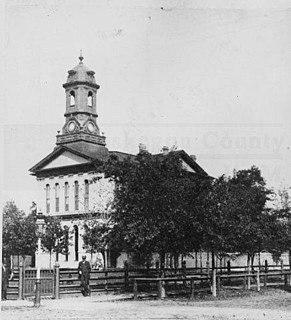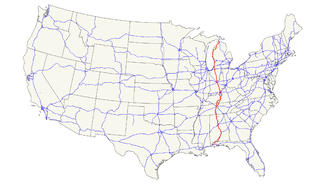The West Michigan Pike Pure Michigan Byway is a Pure Michigan Byway on the Lower Peninsula of the US state of Michigan that follows several different highways, most notably Interstate 94 (I-94), I-196 and US Highway 31 (US 31) and various business routes from the Indiana state line near New Buffalo to the Ludington area. The routing is also mostly part of the Lake Michigan Circle Tour, although it deviates from that tourist route in a few locations in Berrien County. From south to north, the byway specifically follows:
A Pure Michigan Byway is the designation for a segment of the State Trunkline Highway System in the US state of Michigan that is a "scenic, recreational, or historic route that is representative of Michigan's natural and cultural heritage." The designation was created with the name Michigan Heritage Route by the state legislature on June 22, 1993, and since then six historic, seven recreational and seven scenic byways have been designated by the Michigan Department of Transportation (MDOT), and another two have been proposed. These byways have been designated in both the Upper and Lower peninsulas of the state. The current name was adopted on December 30, 2014, and it references the Pure Michigan tourism marketing campaign.

Michigan is a state in the Great Lakes and Midwestern regions of the United States. The state's name, Michigan, originates from the Ojibwe word mishigamaa, meaning "large water" or "large lake". With a population of about 10 million, Michigan is the tenth most populous of the 50 United States, with the 11th most extensive total area, and is the largest state by total area east of the Mississippi River. Its capital is Lansing, and its largest city is Detroit. Metro Detroit is among the nation's most populous and largest metropolitan economies.
Interstate 94 (I-94) is a part of the Interstate Highway System that runs from Billings, Montana, to the Lower Peninsula of the US state of Michigan. In Michigan, it is a state trunkline highway that enters the state south of New Buffalo and runs eastward through several metropolitan areas in the southern section of the state. The highway serves Benton Harbor–St. Joseph near Lake Michigan before turning inland toward Kalamazoo and Battle Creek on the west side of the peninsula. Heading farther east, I-94 passes through rural areas in the middle of the southern Lower Peninsula, crossing I-69 in the process. I-94 then runs through Jackson, Ann Arbor, and portions of Metro Detroit, connecting Michigan's largest city to its main airport. Past the east side of Detroit, the Interstate angles northeasterly through farmlands in The Thumb to Port Huron, where the designation terminates on the Blue Water Bridge at the Canadian border.
- I-94 from the Indiana state line at New Buffalo Township to M-63 in St. Joseph Township;
- M-63 from I-94 in St. Joseph Township through Benton Harbor to I-196/US 31 in Lake Michigan Beach, including a segment that runs concurrently with Business Loop I-94 (BL I-94) in St. Joseph;
- I-196/US 31 from M-63 in Lake Michigan Beach to BL I-196 in South Haven Township;
- BL I-196 from I-196/US 31 in South Haven Township to I-196/US 31 in South Haven;
- I-196/US 31 from BL I-196 in South Haven to BL I-196/US 31 in Laketown Township;
- BL I-196/US 31 from I-196/US 31 in Laketown Township through Holland to US 31 in Holland Township;
- US 31 from BL I-196/US 31 in Holland Township to Bus. US 31 in Norton Shores;
- Business US 31 (Bus. US 31) from US 31 in Norton Shores through Muskegon to US 31 in Muskegon Township;
- US 31 from Bus. US 31 in Muskegon Township to Bus. US 31 in Whitehall Township;
- Bus. US 31 from US 31 in Whitehall Township through Whitehall and Montague to US 31 in Montague Township;
- US 31 from Montague Township to Bus. US 31 in Weare Township;
- Bus. US 31 from US 31 in Weare Township through Pentwater to US 31 on the Weare–Pentwater township line;
- US 31 from the Weare–Pentwater township line to Pere Marquette Township;
- Bus. US 31 from US 31 to US 10 in Pere Marquette Township near Ludington; and
- US 10 from Bus. US 31 in Pere Marquette Township to US 31 in Amber Township. [1]

New Buffalo Township is a civil township of Berrien County in the U.S. state of Michigan. As of the 2010 census, the township population was 2,386. It is the southwesternmost township on the Lower Peninsula of Michigan.

M-63 is a state trunkline highway in the US state of Michigan that runs from M-139 at Scottdale through the cities of Benton Harbor and St. Joseph to Interstate 196/US Highway 31 (I-196/US 31) at exit 7 just outside Hagar Shores. The trunkline runs through residential areas south of St. Joseph and through the central business districts of the twin cities. Further north, M-63 runs along the Lake Michigan shoreline.

Benton Harbor is a city in Berrien County in the U.S. state of Michigan which is located southwest of Kalamazoo, and northwest of South Bend, Indiana. In 2010, the population was 10,038 according to the census. It is the smaller, by population, of the two principal cities in the Niles–Benton Harbor Metropolitan Statistical Area, an area with 156,813 people.








